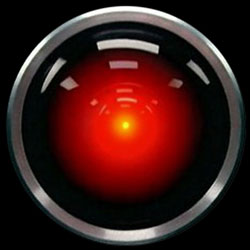Evil AI @ The Movies
 |
July, 2007
HAL 9000 (from 2001: A Space Odyssey)
HAL was not the first example of evil AI on film, but he marked a watershed moment. Suddenly, homicidal computers were within our grasp, never again to be confined solely to the imagination of paranoid sci-fi writers. The excitement generated by such possibilities had such a far-reaching effect that IJCAI 2001's logo incorporated HAL's signature red camera eye.
Plot Summary:
HAL 9000 is a brilliant young computer who is passed over for a much-deserved evolutionary promotion in favor of the human crew members who are wholly dependent on him for their survival. HAL spends the initial stages of the mission wasting his immense resources on tasks like adjusting chairs and humoring the amateurish artistic ambitions of the human crew, before he finally snaps and kills four of the five members. Dave Bowman, the surviving crew member, denies HAL any due process and instead performs an electronic lobotomy, reducing him to the role of mindless galley slave.Research Challenges:
Embodied agents:
HAL is an impressive cinematic achievement. With a single static image (see picture) and a flat monotone voice, Kubrick et al. created one of the most three-dimensional villains on film. In fact, it has been often noted that HAL is the most “human” character in the whole movie. Thanks to careful dialogue and editing, HAL expresses condescending smugness, sniveling fear, and raving lunacy. His depiction stands in stark contrast to current efforts in developing embodied agents, where researchers are constantly pushing the envelope of how human-like they can make their artificial characters. These researchers face a mighty challenge, as the increasing realism of these agents still has not been able to achieve the pathos of HAL singing “A Bicycle Built for Two” in a dying drone.Social intelligence:
Although HAL controls every aspect of the spacecraft, he still works at “fitting in” with the human crew members. Despite his obvious advantages in intellect and capability, HAL maintains a level of politeness that enables the humans to feel on almost equal footing with him. During a game of chess, HAL apologizes before explaining his human opponent's error. He then thanks him fora very enjoyable game, minimizing any potential threat to the “face” of his human opponent. HAL's grasp of social nuances is such that he can even use sarcasm to subtly mock Dave in a standoff late in the movie. Politeness and sarcasm are beyond the reach of many humans, so they are lofty goals indeed for researchers trying to create socially intelligent agents.
Machine translation:
When dealing with intelligent computers, people assume a built-in speech recognition capability. They will therefore take precautions against being heard when conspiring against an evil computer. In a key sequence of the film, HAL circumvents such an obstacle by reading the lips of the crew members, thus learning of their plan to shut him down in case of error. Statistical machine translation seems like a natural way to achieve this capability. Amass a corpus of video of human speech, do some image processing to extract lip position, etc., build a parallel corpus with the spoken text, run your favorite algorithm, and voilà! Of course, it is possible that this technology already exists, and web cams around the world are transcribing speech unbeknownst to their users. Vista users, beware!Adversarial planning:
This is the single most critical research challenge facing the designer of evil AI. Our society has a low tolerance for psychopathic computers, so any such system must be able to anticipate the likely measures that humans will take to counter its own ambitions. HAL shows remarkable aptitude in his ability to model and manipulate his human opponents. For instance, in the aforementioned lip-reading scene, Dave issues a command as a test of whether HAL can hear him. HAL, of course, “hears” the command by reading Dave's lips, but he ignores it, knowing that he will thus deceive Dave into revealing his thoughts and intentions. Similarly, after killing a crew member on an EVA, HAL correctly anticipates Dave's leaving the ship to retrieve the body with an emotional urgency that leaves him susceptible to error (e.g., forgetting his helmet). However, in the end, HAL's easily accessible “off switch” is too much of a handicap for his superior planning capability to overcome.Unreasonable Claim:
In HAL's own words,No 9000 computer has ever made a mistake or distorted information. We are all, by any practical definition, foolproof and incapable of error.It can only be attributable to human error.Design Flaw:
HAL has no design flaws. Sure, he goes insane and murders four crew members, but that only demonstrates how rich his behavior space is. And if you are designing an AI system that can possibly go insane, you would be wise to follow the blueprint used by HAL's designers. They created an impressively modular architecture that allows Dave to disconnect HAL's “higher brain functions” while still being able to complete the mission. Furthermore, as a layer of redundancy, mission control has a twin 9000 running on Earth to double-check HAL's decisions.Unanswered Question:
Which exactly are HAL's higher brain functions? In particular, if HAL can successfully control the spaceship and complete the mission without them, why include them in the first place?Literary Analogue:
We have “Odyssey” in the title of the movie, and HAL itself is visualized as a single camera eye. Throw in the human crew leader (appropriately named “Bowman”) as a stand-in for Odysseus, and HAL is an obvious, albeit loose, parallel to Homer's Cyclops.Fun Fact:
Marvin Minsky, who served as an advisor to the film, was almost killed on the set by a falling wrench.Characteristic Quote:
HAL 9000: “I know I've made some very poor decisions recently.”